Symrise Bundle
Who Really Controls Symrise?
Understanding the ownership structure of a global giant like Symrise is crucial for anyone looking to invest or analyze the company. Knowing Symrise SWOT Analysis, its major shareholders, and the influence of key executives provides vital insights into its strategic direction and future prospects. This knowledge is essential for making informed decisions in the dynamic world of finance.
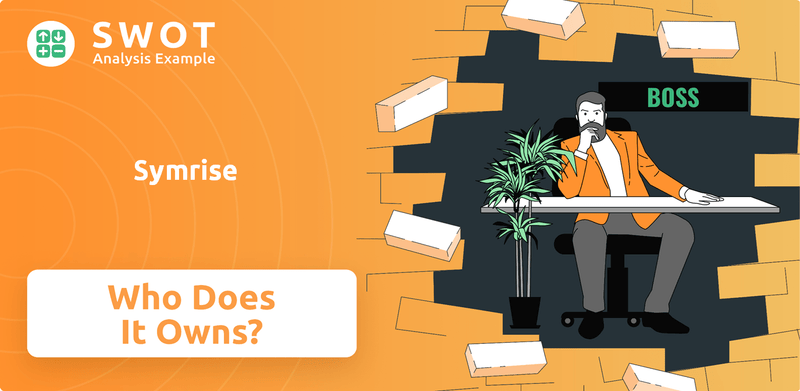
The evolution of Symrise's ownership, from its roots as a merger between Haarmann & Reimer and Dragoco to its current standing, is a fascinating story. Exploring who owns Symrise reveals the driving forces behind its impressive financial performance, including its €4.99 billion in revenue and its position among the top flavor and fragrance companies. This deep dive into Symrise ownership will also shed light on the company's structure and the impact of its shareholders.
Who Founded Symrise?
The story of Symrise AG's ownership begins with the merger of two significant players in the fragrance and flavor industry: Haarmann & Reimer (H&R) and Dragoco. This union, finalized in 2003, laid the foundation for what Symrise is today. Understanding the ownership structure requires looking back at the origins of both companies and how they came together.
H&R was established in 1874 by Ferdinand Tiemann and Wilhelm Haarmann, who made a groundbreaking discovery in the synthesis of vanillin. Dragoco, on the other hand, was founded in 1919 by Carl-Wilhelm Gerberding and August Bellmer. These two companies, with their distinct histories and ownership structures, would eventually merge to form Symrise, creating a new entity with a diverse ownership base.
Before the merger, H&R had been a subsidiary of Bayer since 1953. Dragoco was a privately held company, with Horst-Otto Gerberding, a descendant of one of the founders, holding a significant stake. The merger process involved the private equity firm EQT Northern Private Equity acquiring H&R from Bayer and simultaneously purchasing shares from Dragoco's minority holders. This paved the way for Horst-Otto Gerberding to contribute his shares to the newly formed Symrise, thus finalizing the merger on May 23, 2003.
H&R was founded in 1874 by chemists Ferdinand Tiemann and Wilhelm Haarmann.
Dragoco was established in 1919 by Carl-Wilhelm Gerberding and August Bellmer.
H&R was a subsidiary of Bayer since 1953.
Dragoco was privately held, with Horst-Otto Gerberding as a major shareholder.
The merger of H&R and Dragoco was finalized on May 23, 2003.
EQT acquired H&R from Bayer and shares from Dragoco's minority holders.
The initial ownership of Symrise was thus a blend of EQT, the Gerberding family, and other shareholders from Dragoco. This structure set the stage for Symrise to grow and eventually become a publicly traded company. For more insights into the company's strategic direction, consider reading about the Growth Strategy of Symrise. The early agreements focused on integrating the corporate cultures and aligning the ownership interests of H&R and Dragoco under the new Symrise umbrella, setting the stage for the company's future development. The merger created a company with a strong foundation in the flavor and fragrance industry, poised for further expansion and market leadership. As of 2024, Symrise continues to be a key player in the global market, with a diverse shareholder base.
The formation of Symrise involved the merger of H&R and Dragoco, with EQT playing a key role in acquiring both companies.
- H&R was founded in 1874 by Ferdinand Tiemann and Wilhelm Haarmann.
- Dragoco was founded in 1919 by Carl-Wilhelm Gerberding and August Bellmer.
- The merger was completed on May 23, 2003.
- Horst-Otto Gerberding, from Dragoco, became a significant shareholder in the new entity.
Symrise SWOT Analysis
- Complete SWOT Breakdown
- Fully Customizable
- Editable in Excel & Word
- Professional Formatting
- Investor-Ready Format
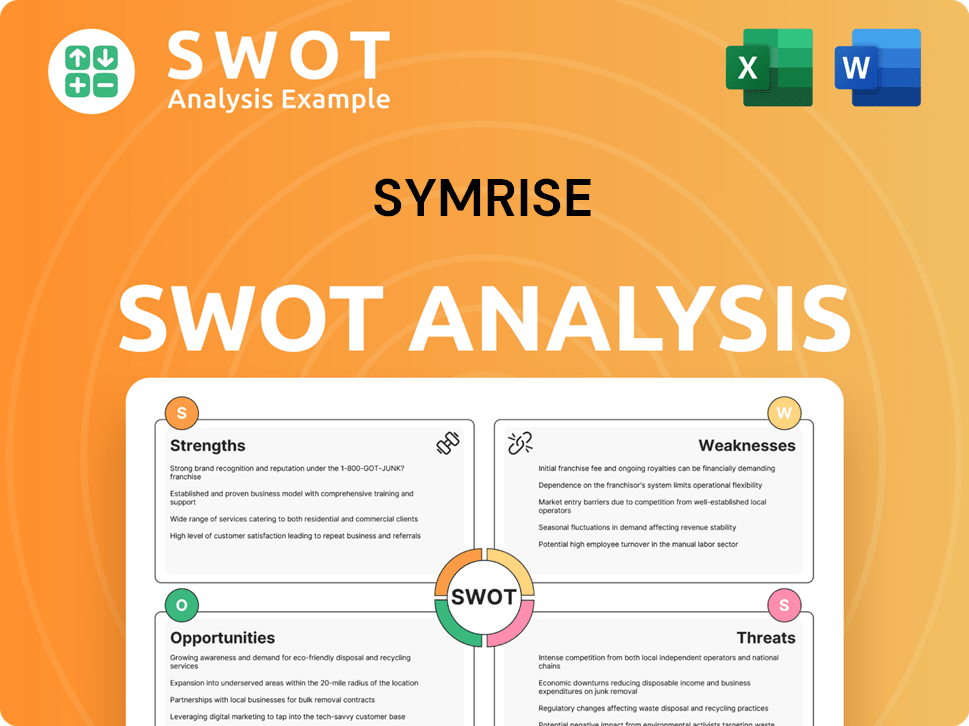
How Has Symrise’s Ownership Changed Over Time?
The ownership structure of the [Company Name], has changed significantly since its inception in 2003. A pivotal moment was the Initial Public Offering (IPO) on the Frankfurt Stock Exchange on December 11, 2006. This IPO involved the issuance of 81,030,358 shares at €17.25 each, raising a total of €1.4 billion. This made it the largest German public offering of that year. The goal of the IPO was to ensure that over 50% of [Company Name] shares would be available for public trading. Following the IPO, [Company Name] was included in the German MDAX stock index on March 19, 2007.
The evolution of [Company Name]'s ownership reflects a shift from its initial private equity and founder control to a more dispersed public ownership model. This transition has seen large institutional investors taking a dominant role in the shareholder landscape. Understanding the ownership structure is crucial for anyone looking into the [Company Name] and its financial performance.
| Shareholder | Stake (May 2025) | Stake (November 2024) |
|---|---|---|
| Massachusetts Financial Services Company | 9.7% (January 2025) | |
| BlackRock Inc. | 6.002% | |
| Norges Bank Investment Management | 5.0021% | |
| Canada Pension Plan Investment Board | 4.997% (April 2025) | |
| Horst-Otto Gerberding | 5.0023% | |
| Gerberding Vermögensverwaltung GmbH | 6.01% |
As of May 2025, [Company Name] has 139,772,054 shares outstanding. Institutional investors hold a significant portion of the company's shares. As of January 2025, approximately 58% of the shares were held by institutions, indicating their influence on stock price movements. Major institutional shareholders include Massachusetts Financial Services Company, BlackRock Inc., Norges Bank Investment Management, and Canada Pension Plan Investment Board. Also, Horst-Otto Gerberding, linked to the founding family, remains a key individual shareholder. For more details on the company's background, you can read this article about [Company Name].
The ownership of [Company Name] has transitioned from private to public, with institutional investors holding a significant stake.
- The IPO in 2006 was a major event, increasing public ownership.
- Institutional investors like BlackRock and Norges Bank have considerable influence.
- Individual shareholders, such as Horst-Otto Gerberding, also play a role.
- Understanding the shareholder structure is key to evaluating the company.
Symrise PESTLE Analysis
- Covers All 6 PESTLE Categories
- No Research Needed – Save Hours of Work
- Built by Experts, Trusted by Consultants
- Instant Download, Ready to Use
- 100% Editable, Fully Customizable
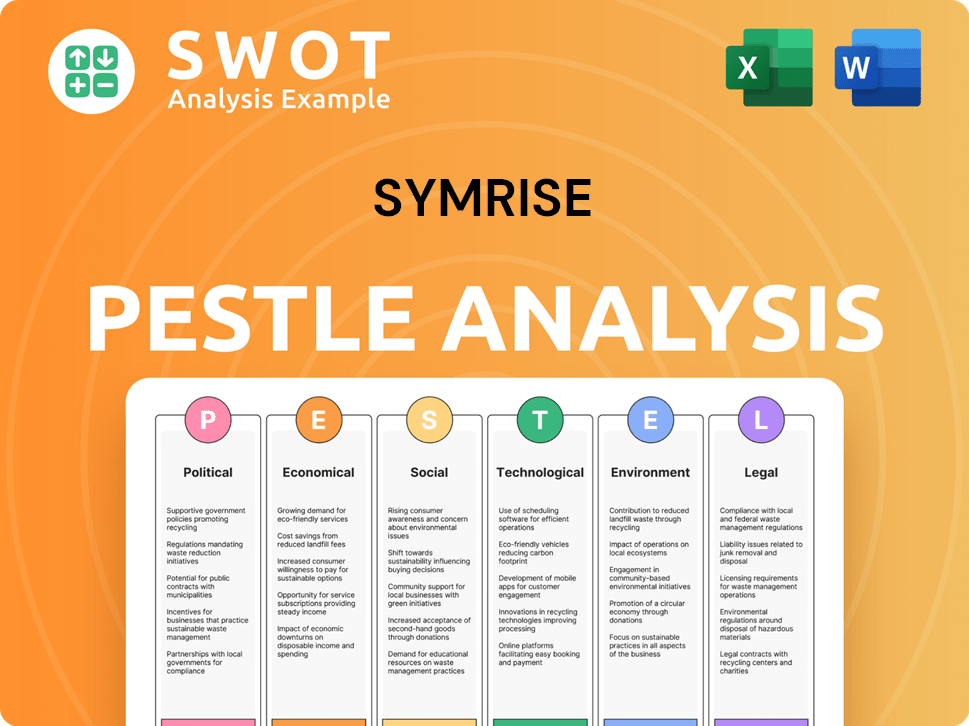
Who Sits on Symrise’s Board?
The current leadership of the Symrise company is structured around an Executive Board and a Supervisory Board. As of March 27, 2025, the Executive Board saw a reorganization. Dr. Jean-Yves Parisot became the new CEO, effective April 1, 2024, and also temporarily leads the Scent & Care segment. The Executive Board also includes Olaf Klinger (CFO), Stephanie Coßmann (President HR), and Walter Ribeiro, who was appointed on September 15, 2024, heading the Taste, Nutrition & Health segment. Michael König chairs the Supervisory Board.
The Supervisory Board plays a crucial role in overseeing the Executive Board and ensuring the company's strategic direction aligns with shareholder interests. Understanding the composition and responsibilities of these boards is essential for anyone interested in the Symrise company's governance and operations. The structure reflects a commitment to established corporate governance practices.
| Executive Board Members | Role | Effective Date |
|---|---|---|
| Dr. Jean-Yves Parisot | CEO & Head of Scent & Care (interim) | April 1, 2024 |
| Olaf Klinger | CFO | N/A |
| Stephanie Coßmann | President HR | N/A |
| Walter Ribeiro | Head of Taste, Nutrition & Health | September 15, 2024 |
The voting structure at Symrise AG generally follows a one-share-one-vote principle. This is typical for publicly traded companies in Germany. There are no indications of special arrangements that would grant disproportionate control to specific individuals or entities beyond their shareholdings. Institutional investors hold a significant stake, with approximately 58% of the shares as of January 2025. These institutional investors collectively have a substantial influence on decision-making within the company. For more insights into the company's marketing strategies, consider reading about the Marketing Strategy of Symrise.
The voting structure at Symrise is straightforward: one share equals one vote. This structure ensures that voting power is directly proportional to share ownership. Institutional investors hold a significant portion of the shares, giving them considerable influence.
- One-share-one-vote principle.
- Significant institutional ownership (approximately 58% as of January 2025).
- Supervisory Board oversees the Executive Board.
- Shareholders re-elected at the Annual General Meeting.
Symrise Business Model Canvas
- Complete 9-Block Business Model Canvas
- Effortlessly Communicate Your Business Strategy
- Investor-Ready BMC Format
- 100% Editable and Customizable
- Clear and Structured Layout
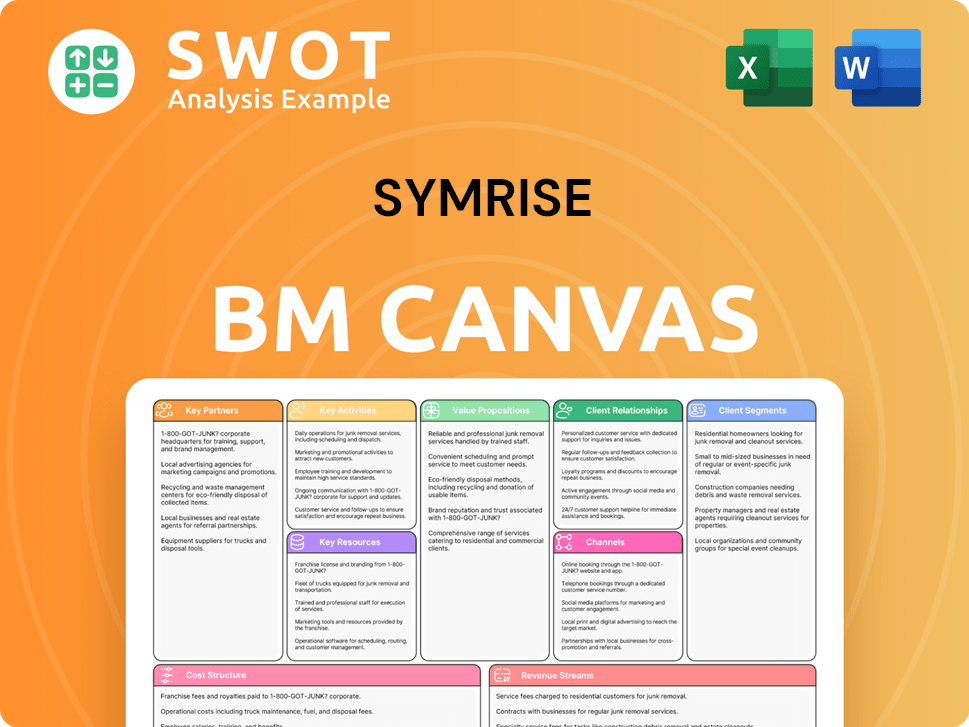
What Recent Changes Have Shaped Symrise’s Ownership Landscape?
Over the past few years, Symrise's ownership profile has seen notable shifts. A key change was the succession of Dr. Jean-Yves Parisot as CEO on March 31, 2024, following Dr. Heinz-Jürgen Bertram's 15-year tenure. This transition, along with other executive board adjustments in September 2024, reflects an evolution in leadership. Institutional investors continue to hold a significant stake in the company.
Institutional ownership remains a key feature of Symrise company, with institutions holding approximately 58% of the shares as of January 2025. Major institutional investors include Massachusetts Financial Services Company, BlackRock Inc., and Norges Bank Investment Management. The company has also been active in strategic acquisitions, such as the acquisition of Sensient Technologies Corporation's fragrance and aroma business in November 2020. More recently, in November 2024, Symrise AG announced a public offer to acquire Probi AB, securing about 90.2% of Probi's outstanding capital by January 2025 through acquisitions and undertakings.
| Metric | Details | Date |
|---|---|---|
| Institutional Ownership | 58% | January 2025 |
| Dividend per Share | EUR 1.20 | May 2025 (Approved) |
| Organic Sales Growth Guidance (FY 2025) | 5% to 7% | FY 2025 |
These developments highlight Symrise's strategic focus on growth and expansion, particularly in the nutrition and health sectors. The company's share buybacks and increased dividend, approved in May 2025 at EUR 1.20 per share, show confidence in its financial performance. The company reiterated its guidance for FY 2025, expecting organic sales growth of 5% to 7% and an EBITDA margin above 20%.
Institutional investors are the primary owners of Symrise, holding a significant majority of shares. This ownership structure indicates a strong level of trust from major financial institutions.
Acquisitions, such as the Probi AB offer, are a key part of Symrise's growth strategy. These moves help expand the company's portfolio and market presence.
Leadership changes, like the CEO transition in 2024, influence the company's strategic direction. These changes often reflect evolving market needs.
The increased dividend and positive sales growth forecasts suggest healthy financial performance. These figures reflect the company's market position and outlook.
Symrise Porter's Five Forces Analysis
- Covers All 5 Competitive Forces in Detail
- Structured for Consultants, Students, and Founders
- 100% Editable in Microsoft Word & Excel
- Instant Digital Download – Use Immediately
- Compatible with Mac & PC – Fully Unlocked
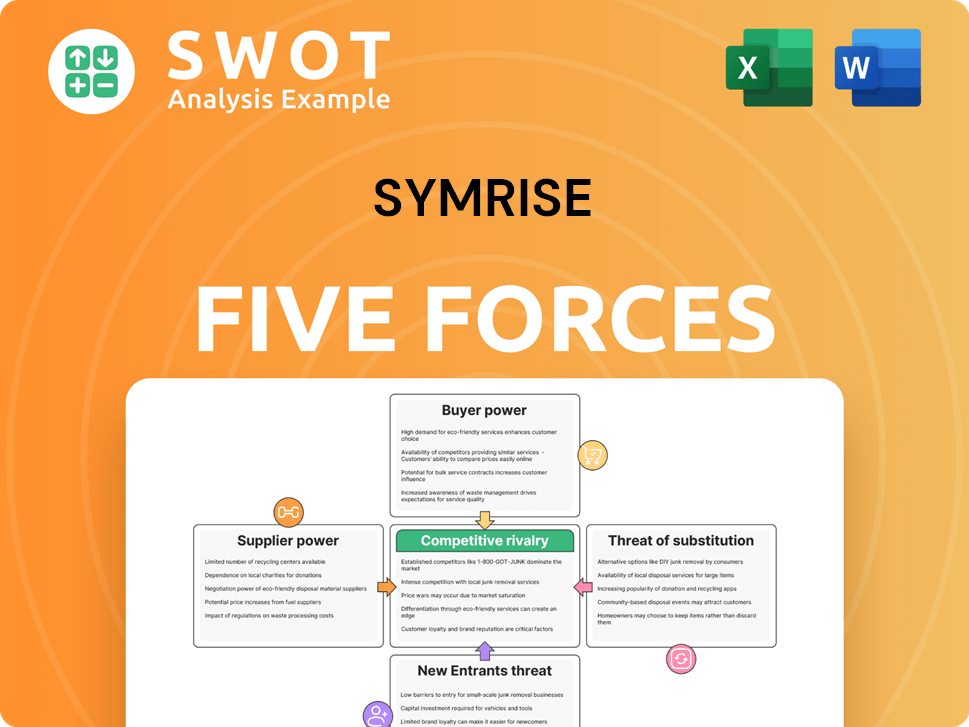
Related Blogs
- What are Mission Vision & Core Values of Symrise Company?
- What is Competitive Landscape of Symrise Company?
- What is Growth Strategy and Future Prospects of Symrise Company?
- How Does Symrise Company Work?
- What is Sales and Marketing Strategy of Symrise Company?
- What is Brief History of Symrise Company?
- What is Customer Demographics and Target Market of Symrise Company?
Disclaimer
All information, articles, and product details provided on this website are for general informational and educational purposes only. We do not claim any ownership over, nor do we intend to infringe upon, any trademarks, copyrights, logos, brand names, or other intellectual property mentioned or depicted on this site. Such intellectual property remains the property of its respective owners, and any references here are made solely for identification or informational purposes, without implying any affiliation, endorsement, or partnership.
We make no representations or warranties, express or implied, regarding the accuracy, completeness, or suitability of any content or products presented. Nothing on this website should be construed as legal, tax, investment, financial, medical, or other professional advice. In addition, no part of this site—including articles or product references—constitutes a solicitation, recommendation, endorsement, advertisement, or offer to buy or sell any securities, franchises, or other financial instruments, particularly in jurisdictions where such activity would be unlawful.
All content is of a general nature and may not address the specific circumstances of any individual or entity. It is not a substitute for professional advice or services. Any actions you take based on the information provided here are strictly at your own risk. You accept full responsibility for any decisions or outcomes arising from your use of this website and agree to release us from any liability in connection with your use of, or reliance upon, the content or products found herein.